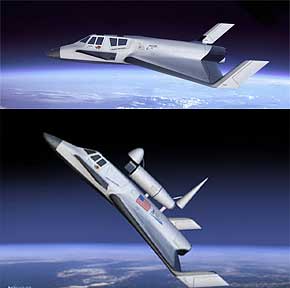XCOR Xerus
The XCOR Xerus is a spacecraft that will be using a different
approach to getting tourists and payload in space compared
to other vehicles of the same class.
|
|

XCOR Xerus |
XCOR Aerospace, a leader in the aeronautics field, is developing
a space plane that has piqued the interest of many inside
and outside the industry.
Capable of transporting personnel and cargo, the Xerus space
plane will be a coveted vehicle for NASA and other organizations
because Xerus will be able to launch microsatellites into
low Earth orbit (LEO) as well as transporting tourists to
space.
The Xerus space plane is being designed more economically
compared to the space shuttles launched by various aeronautics
programs or rockets launched by other budding space tourism
companies. To hold down costs, the XCOR Xerus will depart
using a runway rather than a launch pad, fly into LEO at about
60 miles and then be capable to be flown as a typical airplane
upon return, allowing the landing phase to be more controlled.
The three commercial areas that the XCOR Xerus space plane
is being developed for include enabling microgravity research
experiments, microsatellite launch and space tourism. The
space tourism rides on the XCOR Xerus will involve trips of
at least 30 minutes to LEO with 3 minutes of zero gravity
for around $98,000.
The XCOR Xerus space plane is still in the design phase,
but the initial designs in 2003 called for the vehicle to
use liquid oxygen (LOX) and kerosene as propellant as another
method to hold down costs, yet provide enough power to fly
to and return from space. Newer fuel technology just developed
may be used instead.
XCOR Aerospace has been conducting successful experiments
for NASA using liquid methane as propellant. Methane has always
been associated as a foul smelling gas produced by cows, swamps,
and even humans but now XCOR researchers believe that the
liquid version will become the future fuel of rockets.
The abundance of methane in the environment and the ease
at which it can be liquefied will substantially decrease the
cost of traveling into space given the present price of energy.
Methane is not only prevalent on Earth but also in space and
other planets and moons, including Mars, Jupiter, and Saturn's
moon Titan, which increases the likelihood of interplanetary
journeys in the distant future.
Concerns have arisen with the use of methane as fuel due
to its untested nature. That is until now. XCOR Aerospace
earlier this year successfully launched six rockets equipped
with hefty 7,500-pound thrust rocket engines.
These specific engines combine liquid oxygen and liquid methane,
at supersonic speeds, to produce propulsion capable of producing
almost four tons of force. At the same time, this propulsion
system is perfectly safe to humans as opposed to the toxic
hydrocarbons used by space companies at the present time.
The XCOR Xerus space plane is based upon the research and
development of a smaller vehicle the EZ-Rocket. The EZ-Rocket
has flown 26 times, setting one official record and several
unofficial one and has been shown at several major air shows.
The EZ-Rocket is not a suborbital plane and this is where
the Xerus steps in and steps up the game.
The XCOR Xerus is currently being developed at the company's
Mojave Desert facility in California. The expected launch
date for the first commercial flight is in 2009 or 2010.
|

